Abstract
Eighty-seven patients were entered into a randomized, prospective, double-blind, six-center study to evaluate the effect of amino acid loading and a formula that was branched chain enriched (50%) on nitrogen retention in metabolic stress. The patients had varying levels of metabolic stress (0-3) after major surgery, polytrauma, or surgical sepsis. The study was isocaloric and isonitrogenous and lasted for 7 days. The patients received either a standard amino acid formula (SAA) (Travasol) or a 50% branched chain enriched formula that was equimolar, leucine, isoleucine, and valine (MAA) (Travasol + Branchamin concentrate) at a dose of 1.0-2.0 g/kg/day in a fixed ratio with 114 glucose calories per gram of nitrogen administered. The nitrogen retention was proportionate to the nitrogen (and, therefore, caloric) load in both groups. The MAA group, however, had better nitrogen retention, reached nitrogen equilibrium at a lower dose of amino acids, and had less urinary nitrogen excretion per gram of nitrogen administered. Since the groups were isonitrogenous and the calorie to nitrogen ratios were fixed, it appears that nitrogen equilibrium in surgical stress is proportionate to the amino acid load over a range of 0.05-0.4 g/kg/day of nitrogen; and that MAA are more efficient at inducing nitrogen retention and a reduction in urea excretion. These effects on nitrogen retention were more significant at level 2 stress or greater. At these higher stress levels, a dose of 2 +/- 0.2 g/kg/day of MAA seemed most efficient in promoting nitrogen retention.
Full text
PDF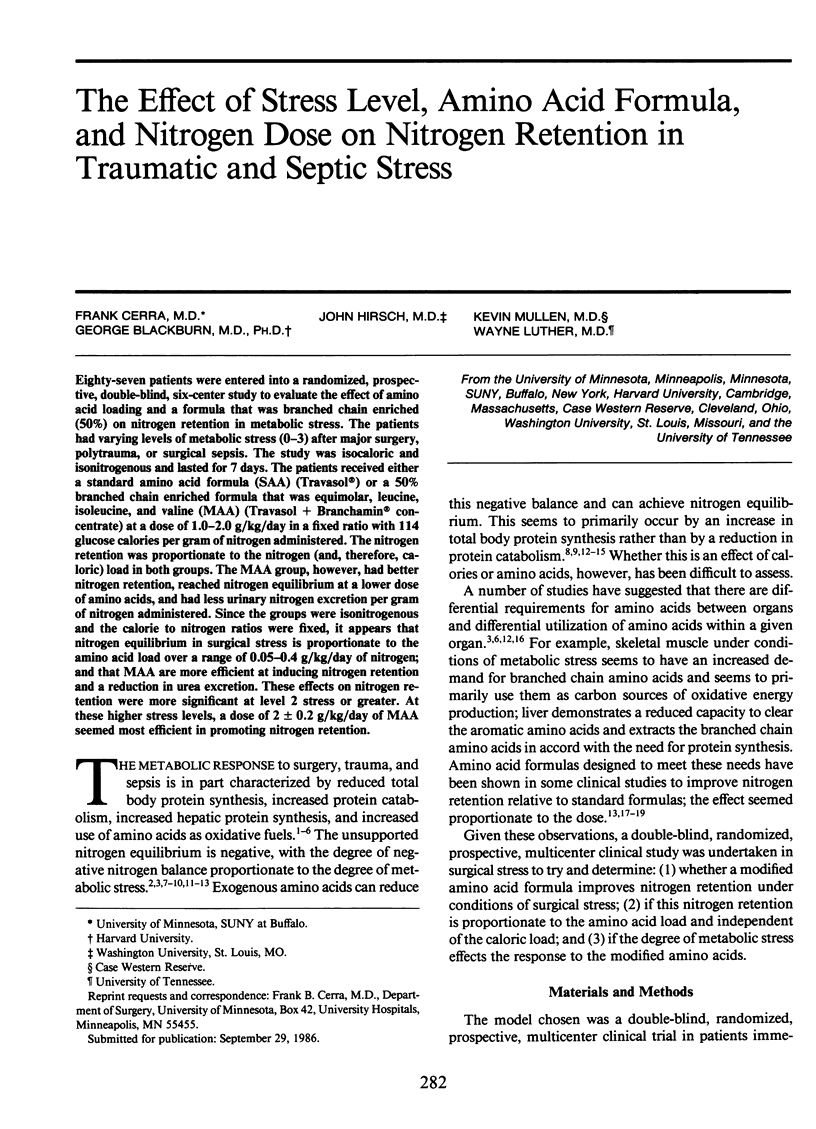
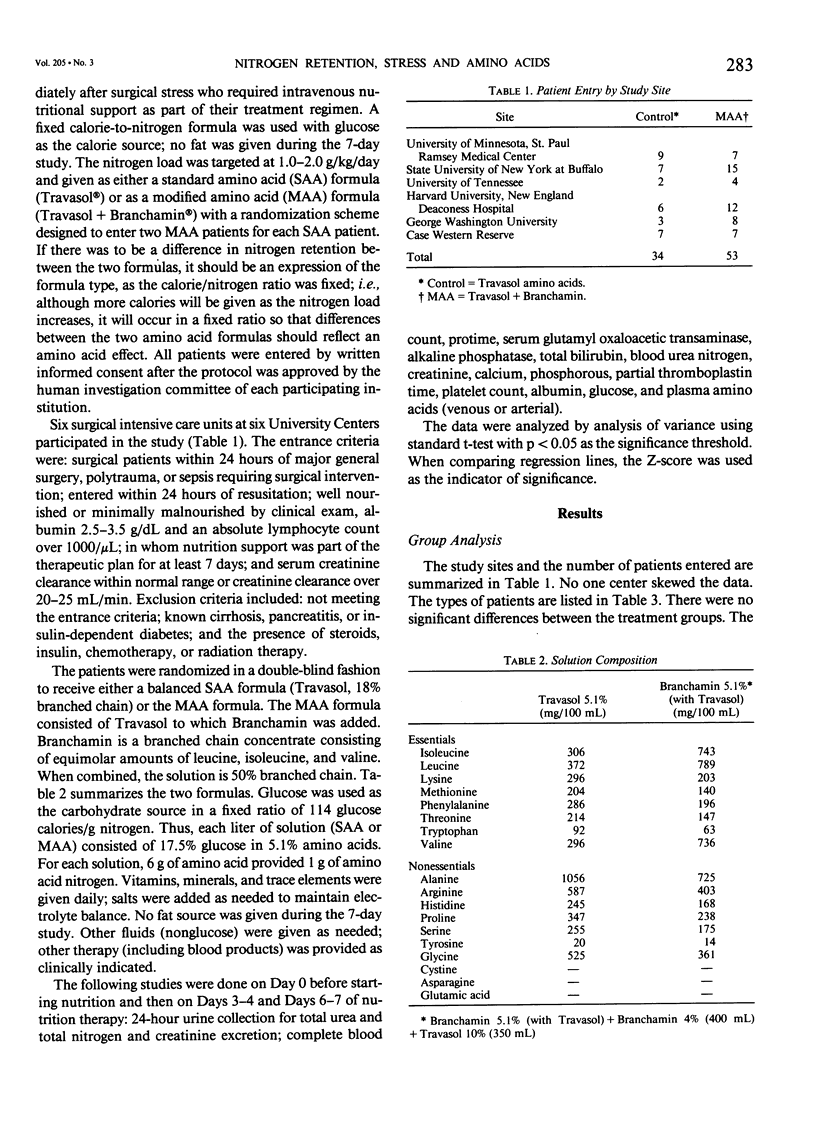
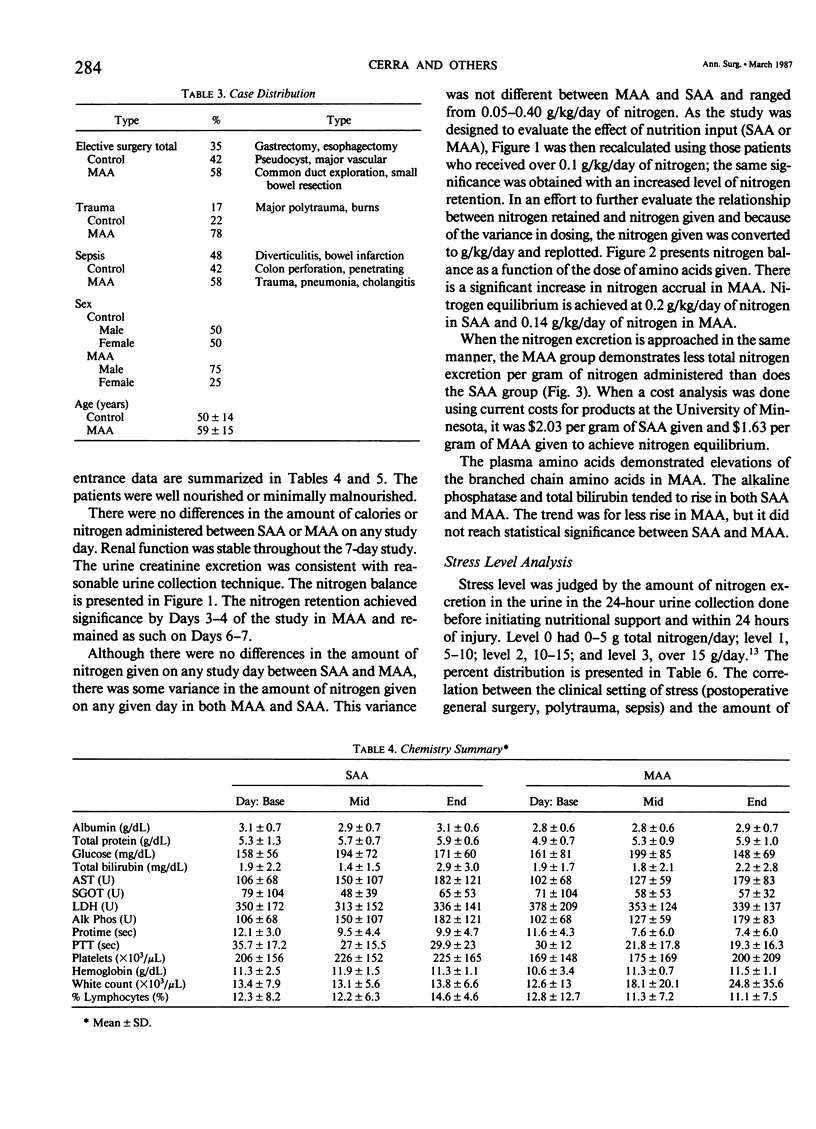
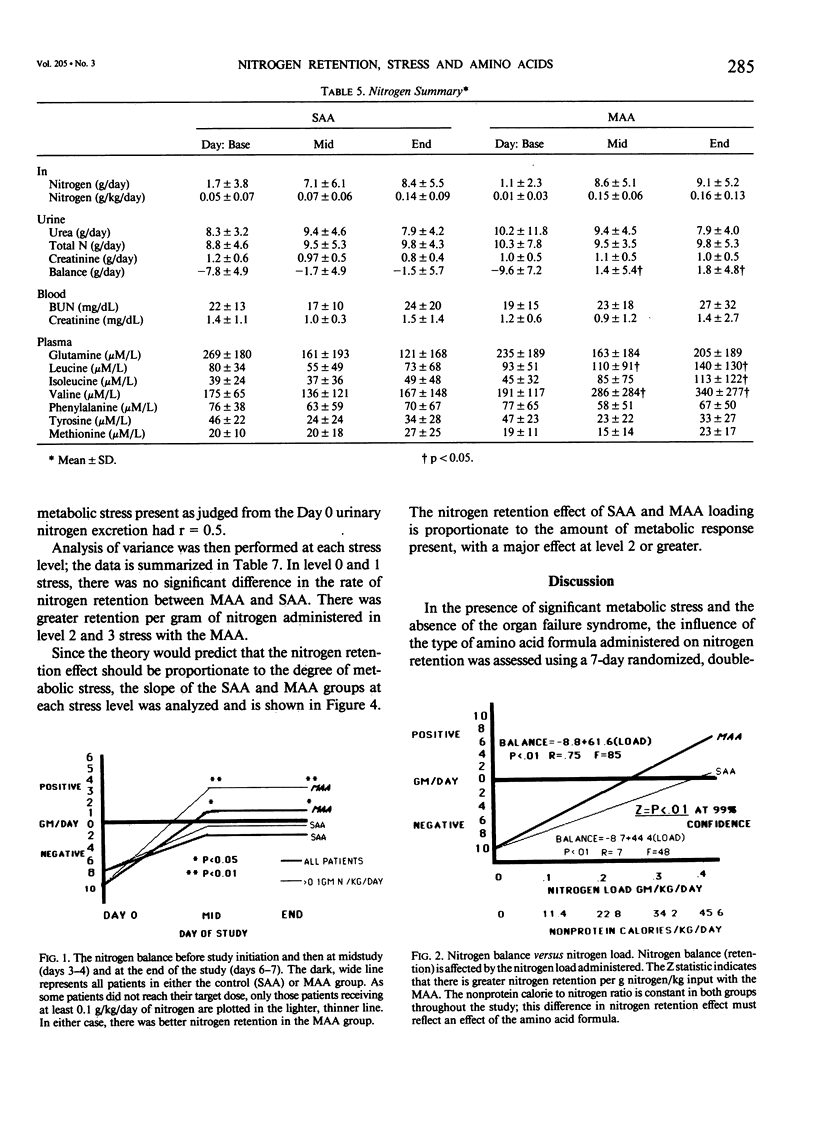

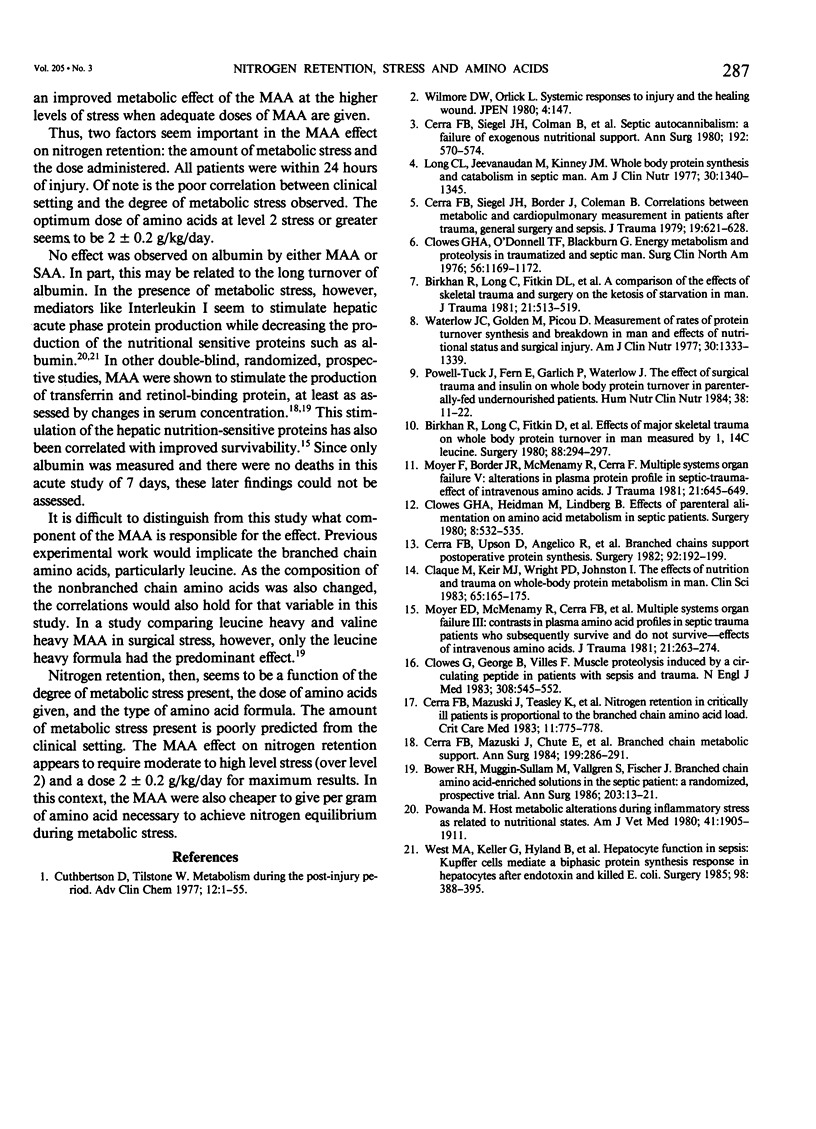
Selected References
These references are in PubMed. This may not be the complete list of references from this article.
- Birkhahn R. H., Long C. L., Fitkin D. L., Busnardo A. C., Geiger J. W., Blakemore W. S. A comparison of the effects of skeletal trauma and surgery on the ketosis of starvation in man. J Trauma. 1981 Jul;21(7):513–519. doi: 10.1097/00005373-198107000-00002. [DOI] [PubMed] [Google Scholar]
- Birkhahn R. H., Long C. L., Fitkin D., Geiger J. W., Blakemore W. S. Effects of major skeletal trauma on whole body protein turnover in man measured by L-[1,14C]-leucine. Surgery. 1980 Aug;88(2):294–300. [PubMed] [Google Scholar]
- Bower R. H., Muggia-Sullam M., Vallgren S., Hurst J. M., Kern K. A., LaFrance R., Fischer J. E. Branched chain amino acid-enriched solutions in the septic patient. A randomized, prospective trial. Ann Surg. 1986 Jan;203(1):13–20. doi: 10.1097/00000658-198601000-00003. [DOI] [PMC free article] [PubMed] [Google Scholar]
- Cerra F. B., Mazuski J. E., Chute E., Nuwer N., Teasley K., Lysne J., Shronts E. P., Konstantinides F. N. Branched chain metabolic support. A prospective, randomized, double-blind trial in surgical stress. Ann Surg. 1984 Mar;199(3):286–291. doi: 10.1097/00000658-198403000-00007. [DOI] [PMC free article] [PubMed] [Google Scholar]
- Cerra F. B., Mazuski J., Teasley K., Nuwer N., Lysne J., Shronts E., Konstantinides F. Nitrogen retention in critically ill patients is proportional to the branched chain amino acid load. Crit Care Med. 1983 Oct;11(10):775–778. doi: 10.1097/00003246-198310000-00003. [DOI] [PubMed] [Google Scholar]
- Cerra F. B., Siegel J. H., Border J. R., Peters D. M., McMenamy R. R. Correlations between metabolic and cardiopulmonary measurements in patients after trauma, general surgery, and sepsis. J Trauma. 1979 Aug;19(8):621–629. doi: 10.1097/00005373-197908000-00010. [DOI] [PubMed] [Google Scholar]
- Cerra F. B., Siegel J. H., Coleman B., Border J. R., McMenamy R. R. Septic autocannibalism. A failure of exogenous nutritional support. Ann Surg. 1980;192(4):570–580. doi: 10.1097/00000658-198010000-00015. [DOI] [PMC free article] [PubMed] [Google Scholar]
- Cerra F. B., Upson D., Angelico R., Wiles C., 3rd, Lyons J., Faulkenbach L., Paysinger J. Branched chains support postoperative protein synthesis. Surgery. 1982 Aug;92(2):192–199. [PubMed] [Google Scholar]
- Clague M. B., Keir M. J., Wright P. D., Johnston I. D. The effects of nutrition and trauma on whole-body protein metabolism in man. Clin Sci (Lond) 1983 Aug;65(2):165–175. doi: 10.1042/cs0650165. [DOI] [PubMed] [Google Scholar]
- Clowes G. H., Jr, George B. C., Villee C. A., Jr, Saravis C. A. Muscle proteolysis induced by a circulating peptide in patients with sepsis or trauma. N Engl J Med. 1983 Mar 10;308(10):545–552. doi: 10.1056/NEJM198303103081001. [DOI] [PubMed] [Google Scholar]
- Clowes G. H., Jr, O'Donnell T. F., Blackburn G. L., Maki T. N. Energy metabolism and proteolysis in traumatized and septic man. Surg Clin North Am. 1976 Oct;56(5):1169–1184. doi: 10.1016/s0039-6109(16)41036-4. [DOI] [PubMed] [Google Scholar]
- Cuthbertson D., Tilstone W. J. Metabolism during the postinjury period. Adv Clin Chem. 1969;12:1–55. doi: 10.1016/s0065-2423(08)60257-7. [DOI] [PubMed] [Google Scholar]
- Long C. L., Jeevanandam M., Kim B. M., Kinney J. M. Whole body protein synthesis and catabolism in septic man. Am J Clin Nutr. 1977 Aug;30(8):1340–1344. doi: 10.1093/ajcn/30.8.1340. [DOI] [PubMed] [Google Scholar]
- Moyer E. D., Border J. R., McMenamy R. H., Caruana J., Chenier R., Cerra F. B. Multiple systems organ failure: V. Alterations in the plasma protein profile in septic trauma - effects of intravenous amino acids. J Trauma. 1981 Aug;21(8):645–649. [PubMed] [Google Scholar]
- Moyer E. D., McMenamy R. H., Cerra F. B., Reed R. A., Yu L., Chenier R., Caruana J., Border J. R. Multiple systems organ failure: III Contrasts in plasma amino acid profiles in septic trauma patients who subsequently survive and do not survive-effects of intravenous amino acids. J Trauma. 1981 Apr;21(4):263–274. [PubMed] [Google Scholar]
- Powanda M. C. Host metabolic alterations during inflammatory stress as related to nutritional status. Am J Vet Res. 1980 Nov;41(11):1905–1911. [PubMed] [Google Scholar]
- Powell-Tuck J., Fern E. B., Garlick P. J., Waterlow J. C. The effect of surgical trauma and insulin on whole-body protein turnover in parenterally-fed undernourished patients. Hum Nutr Clin Nutr. 1984 Jan;38(1):11–22. [PubMed] [Google Scholar]
- Waterlow J. C., Golden J., Picou D. The measurements of rates of protein turnover, synthesis, and breakdown in man and the effects of nutritional status and surgical injury. Am J Clin Nutr. 1977 Aug;30(8):1333–1339. doi: 10.1093/ajcn/30.8.1333. [DOI] [PubMed] [Google Scholar]
- West M. A., Keller G. A., Hyland B. J., Cerra F. B., Simmons R. L. Hepatocyte function in sepsis: Kupffer cells mediate a biphasic protein synthesis response in hepatocytes after exposure to endotoxin or killed Escherichia coli. Surgery. 1985 Sep;98(3):388–395. [PubMed] [Google Scholar]
- Wilmore D. W., Aulick L. H. Systemic responses to injury and the healing wound. JPEN J Parenter Enteral Nutr. 1980 Mar-Apr;4(2):147–151. doi: 10.1177/014860718000400215. [DOI] [PubMed] [Google Scholar]


